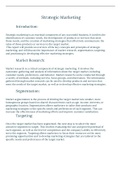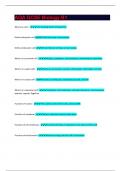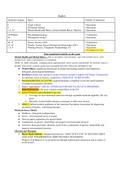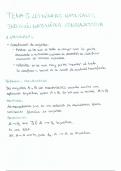Greenwich University
Lecturer:Dr Jeff Powell
BSc Econ
Macroeconomics 1; Aggregate supply and demand 2
06/03/2023
ADMIN
Admin- reminder again the EC for essay is March 10 th so if not managed to hand in (24th
Feb )don’t miss out on EC opportunity. Pass on to colleagues
Optional module choice for second year 17/3- Moodle page – all resources you need speak
to people etc, module leaders
Greenwich students ‘survey- please respond to this so we can assess effectiveness of
programme level data. Helps improve your experience
REAL WORLD DYNAMICS OF FISCAL POLICY DECISIONS - ARTICLE
Tory austerity – Larry Elliot article ( Guardian) refers to report from Greenwich academic- Rob
Jump) which questions the conclusions of Cameron etc 2010-2016 that there is no choice but to
implement austerity
Pro- austerity argument was that this policy ( cutbacks to fiscal expenditure) would :
Ensure interest rates were lower and increase confidence in private sector in public sector
management responsibility which would drive investment up
Control wages in public sector- which would influence private sector wage restraint> lead to
improved exports and competitiveness
Greenwich report – found in their model that while austerity choice was successful re
wage shock , was not successful re investment- austerity did not generate investment,
growth, and investment has remained low. Means debt to gdp ratio has not decreased as
expected prior to austerity.
Report also argues that if gov from 2010 had continued to spend on annual growth level
of past but added tax increases, public spending could have been continued at a level
which would have avoided health and education crisis, was better prepared for Covid
and debt/ gdp ratio would be lower because of investment in public expenditure
3 key dynamics of deficit and debt
fiscal expenditure
inflation
growth- investment and productivity
No empirical evidence from last decade in UK that you have to slash public spending to raise GDP/
debt ratio
UK worse shape than anywhere else in OECD;BREXIT confounds position but from 2015 2016 –
better growth could have been achieved with different fiscal policy.
This is the real world impact of macroeconomics
1
, Greenwich University
Lecturer:Dr Jeff Powell
BSc Econ
Macroeconomics 1; Aggregate supply and demand 2
06/03/2023
AGGREGATE DEMAND AND SUPPLY 2 ( ADAS)
Finish this up.
Graph one
Traditional interpreration of this is that the aggregate demand curve is downward sloping
and aggregate supply curve is is upwards sloping and assumed that this is the state of
economy at all stages of business cycle
This is possible, but does not reflect the possibility that there may be vertical demand
curves and supply curve may be horizontal.
Be aware that the slope of the curves are critical
Showing how using two different views of this model leads to different conclusions and
underlines pull between neo classical economic and Keynesian theory
APPLYING THE MODEL
See textbook
Eurozone crisis
After Euro crisis- solution was austerity.Aim was to bring down gov expenditure in Portugal
Ireland and Spain but no adjustment where countries run smaller deficits and current
account reserves
Greece not same as Germany in 2010- same currency and interest rate but Greek Gov
could not repay debt so bond yield started to diverge
Solution- - Greek gov has to cut public spending raise taxes and structural reforms to restore
investor confidence
UK followed this plan in response to crisis though not a member of the Euro
Key – remember crisis was private sector bank driven crisis- answer was to cut public
spending
In UK no increase in taxes but cut spending> and UK had already liberalized trade
employment and investment
Theory
Graph 1- ADAS model traditional interpretation of model. See flat version of curve but
rising to vertical portion of AS curve; downwards sloping aggregate demand curve
With traditional model,if investors lose confidence, investment falls, unemployment rises ,
demand falls so leftward shift of demand curve .Will move from A0 to new equilibrium e at
2, which is similar inflation rate with lower output than previous equilibrium
2
Lecturer:Dr Jeff Powell
BSc Econ
Macroeconomics 1; Aggregate supply and demand 2
06/03/2023
ADMIN
Admin- reminder again the EC for essay is March 10 th so if not managed to hand in (24th
Feb )don’t miss out on EC opportunity. Pass on to colleagues
Optional module choice for second year 17/3- Moodle page – all resources you need speak
to people etc, module leaders
Greenwich students ‘survey- please respond to this so we can assess effectiveness of
programme level data. Helps improve your experience
REAL WORLD DYNAMICS OF FISCAL POLICY DECISIONS - ARTICLE
Tory austerity – Larry Elliot article ( Guardian) refers to report from Greenwich academic- Rob
Jump) which questions the conclusions of Cameron etc 2010-2016 that there is no choice but to
implement austerity
Pro- austerity argument was that this policy ( cutbacks to fiscal expenditure) would :
Ensure interest rates were lower and increase confidence in private sector in public sector
management responsibility which would drive investment up
Control wages in public sector- which would influence private sector wage restraint> lead to
improved exports and competitiveness
Greenwich report – found in their model that while austerity choice was successful re
wage shock , was not successful re investment- austerity did not generate investment,
growth, and investment has remained low. Means debt to gdp ratio has not decreased as
expected prior to austerity.
Report also argues that if gov from 2010 had continued to spend on annual growth level
of past but added tax increases, public spending could have been continued at a level
which would have avoided health and education crisis, was better prepared for Covid
and debt/ gdp ratio would be lower because of investment in public expenditure
3 key dynamics of deficit and debt
fiscal expenditure
inflation
growth- investment and productivity
No empirical evidence from last decade in UK that you have to slash public spending to raise GDP/
debt ratio
UK worse shape than anywhere else in OECD;BREXIT confounds position but from 2015 2016 –
better growth could have been achieved with different fiscal policy.
This is the real world impact of macroeconomics
1
, Greenwich University
Lecturer:Dr Jeff Powell
BSc Econ
Macroeconomics 1; Aggregate supply and demand 2
06/03/2023
AGGREGATE DEMAND AND SUPPLY 2 ( ADAS)
Finish this up.
Graph one
Traditional interpreration of this is that the aggregate demand curve is downward sloping
and aggregate supply curve is is upwards sloping and assumed that this is the state of
economy at all stages of business cycle
This is possible, but does not reflect the possibility that there may be vertical demand
curves and supply curve may be horizontal.
Be aware that the slope of the curves are critical
Showing how using two different views of this model leads to different conclusions and
underlines pull between neo classical economic and Keynesian theory
APPLYING THE MODEL
See textbook
Eurozone crisis
After Euro crisis- solution was austerity.Aim was to bring down gov expenditure in Portugal
Ireland and Spain but no adjustment where countries run smaller deficits and current
account reserves
Greece not same as Germany in 2010- same currency and interest rate but Greek Gov
could not repay debt so bond yield started to diverge
Solution- - Greek gov has to cut public spending raise taxes and structural reforms to restore
investor confidence
UK followed this plan in response to crisis though not a member of the Euro
Key – remember crisis was private sector bank driven crisis- answer was to cut public
spending
In UK no increase in taxes but cut spending> and UK had already liberalized trade
employment and investment
Theory
Graph 1- ADAS model traditional interpretation of model. See flat version of curve but
rising to vertical portion of AS curve; downwards sloping aggregate demand curve
With traditional model,if investors lose confidence, investment falls, unemployment rises ,
demand falls so leftward shift of demand curve .Will move from A0 to new equilibrium e at
2, which is similar inflation rate with lower output than previous equilibrium
2










